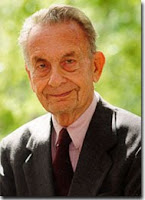 |
| George Gerbner |
Gerbner said that when audiences watch TV with the involvement of religious, they're hoping for a 'violence'. Violence is the drama of the simplest and least expensive is intended to show who was winning in the game of life and regulatory requirements in these games.
An index of violence
Hint of violence is a formula that includes the ratio of the program that makes 'violence', the basis of 'violence' in the program implemented, the percentage of involvement of the characters in the physical crime and murder. Gerbner found that the index is quite stable from year to year.
Equal violence, unequal risk
Gerbner researching about violence on TV appearances. He stated that the delivery of violence or violence on TV would produce a result on the audience. There is a risk that must be paid if the show of violence in TV programs. Though the program will be placed on prime-time, but will still present a risk. Even a different risk of violence at the same impressions.
Establishing a profile viewer
Gerbner classify two kinds of TV viewers, namely light and heavy. Included in the group, light viewers are those who watch TV two times a day. While those who are heavy viewers, including viewers who watch TV four times a day even more.
Mind plowed by television grow fearful thoughts
In this section, Gerbner deliver four differences between groups of spectators in the audience at the group of heavy-light, namely:
1. Possible involvement in violence
Heavy viewers are more likely to engage in criminal activity. Their habits are more likely to physically attack.
2. Fear when walking alone at night
Heavy viewers more afraid because they were always interpreted the excessive about criminal scene in a TV programs. As a result they always imagine if it happened in real life.
Three. Feel or assess police activity
Heavy viewers believe that this community has a 5% involvement in the implementation of the law. Thus they considered that the world is people who are police agents, judges, and government. While the audience to interpret with a more realistic light, is 1%.
4. Suspicion on the people in general
Heavy viewers are more likely to suspect the motives of others. While the audience does not light.
Mainstreaming
Gerbner describes the process of mainstreaming as a blur, blending, and bend which occurs in heavy viewers unconsciously. He thinks that through the impressions and images of the same labels constantly, television is considered to develop a common view by the public.
;
Television produced widely to attract a larger audience possible by providing mainstream models. Equate television audience that they are in the habit of heavy viewers who share the orientation, perspective and same meaning to each other.
Resonance
Gerbner also explained about the other forms, namely resonance. Every person has experienced something that made the trauma. For example, robbed, accidents, fights, and so forth. Trauma is certainly quite an impression, but Gerbner think that the pictures are repeated or aired on television regarding viewer experiencing trauma can cause trauma that occurs constantly in his thoughts or experienced anything like real.
Critique: Is the cultivation differential, real, large, crucial?
For most observations, Gerbner claims that the contents of the television dramatization create a climate of fear quite reasonable. How biased habits of viewers watching too much violence without having experienced a long-lasting effects?
The communication researcher Michael Morgan and James Shanahan register systematically critique of the theory of Gerbner and respond to the charge. In some cases, cultivation theory is to maintain the substance of the greatness of a specific criticism before they focus on research methodology.
__THISRES__148836.jpg)
0 komentar:
Post a Comment